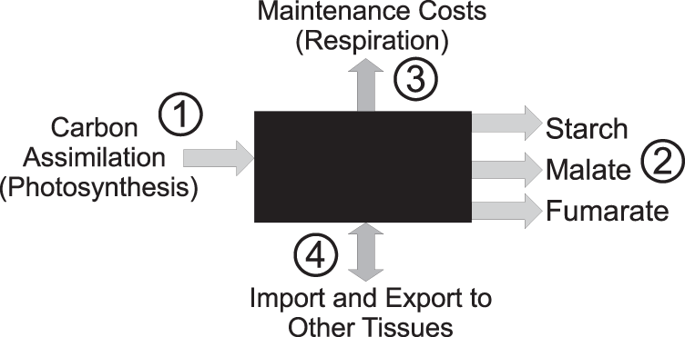当前位置:
X-MOL 学术
›
npj Syst. Biol. Appl.
›
论文详情
Our official English website, www.x-mol.net, welcomes your
feedback! (Note: you will need to create a separate account there.)
Flux sampling is a powerful tool to study metabolism under changing environmental conditions.
npj Systems Biology and Applications ( IF 3.5 ) Pub Date : 2019-09-02 , DOI: 10.1038/s41540-019-0109-0 Helena A Herrmann 1 , Beth C Dyson 1, 2 , Lucy Vass 3, 4 , Giles N Johnson 1 , Jean-Marc Schwartz 3
npj Systems Biology and Applications ( IF 3.5 ) Pub Date : 2019-09-02 , DOI: 10.1038/s41540-019-0109-0 Helena A Herrmann 1 , Beth C Dyson 1, 2 , Lucy Vass 3, 4 , Giles N Johnson 1 , Jean-Marc Schwartz 3
Affiliation

|
The development of high-throughput 'omic techniques has sparked a rising interest in genome-scale metabolic models, with applications ranging from disease diagnostics to crop adaptation. Efficient and accurate methods are required to analyze large metabolic networks. Flux sampling can be used to explore the feasible flux solutions in metabolic networks by generating probability distributions of steady-state reaction fluxes. Unlike other methods, flux sampling can be used without assuming a particular cellular objective. We have undertaken a rigorous comparison of several sampling algorithms and concluded that the coordinate hit-and-run with rounding (CHRR) algorithm is the most efficient based on both run-time and multiple convergence diagnostics. We demonstrate the power of CHRR by using it to study the metabolic changes that underlie photosynthetic acclimation to cold of Arabidopsis thaliana plant leaves. In combination with experimental measurements, we show how the regulated interplay between diurnal starch and organic acid accumulation defines the plant acclimation process. We confirm fumarate accumulation as a requirement for cold acclimation and further predict γ-aminobutyric acid to have a key role in metabolic signaling under cold conditions. These results demonstrate how flux sampling can be used to analyze the feasible flux solutions across changing environmental conditions, whereas eliminating the need to make assumptions which introduce observer bias.
中文翻译:

通量采样是研究不断变化的环境条件下新陈代谢的强大工具。
高通量组学技术的发展引发了人们对基因组规模代谢模型日益浓厚的兴趣,其应用范围从疾病诊断到作物适应。分析大型代谢网络需要高效、准确的方法。通量采样可通过生成稳态反应通量的概率分布来探索代谢网络中可行的通量解决方案。与其他方法不同,通量采样可以在不假设特定细胞目标的情况下使用。我们对几种采样算法进行了严格的比较,并得出结论:基于运行时和多重收敛诊断,坐标舍入运行 (CHRR) 算法是最有效的。我们通过使用 CHRR 研究拟南芥植物叶片光合适应寒冷的代谢变化来证明 CHRR 的力量。结合实验测量,我们展示了昼间淀粉和有机酸积累之间的调节相互作用如何定义植物的适应过程。我们确认富马酸积累是冷驯化的必要条件,并进一步预测γ-氨基丁酸在寒冷条件下的代谢信号传导中发挥关键作用。这些结果证明了如何使用通量采样来分析不断变化的环境条件下的可行通量解决方案,同时消除了引入观察者偏差的假设的需要。
更新日期:2019-09-02
中文翻译:

通量采样是研究不断变化的环境条件下新陈代谢的强大工具。
高通量组学技术的发展引发了人们对基因组规模代谢模型日益浓厚的兴趣,其应用范围从疾病诊断到作物适应。分析大型代谢网络需要高效、准确的方法。通量采样可通过生成稳态反应通量的概率分布来探索代谢网络中可行的通量解决方案。与其他方法不同,通量采样可以在不假设特定细胞目标的情况下使用。我们对几种采样算法进行了严格的比较,并得出结论:基于运行时和多重收敛诊断,坐标舍入运行 (CHRR) 算法是最有效的。我们通过使用 CHRR 研究拟南芥植物叶片光合适应寒冷的代谢变化来证明 CHRR 的力量。结合实验测量,我们展示了昼间淀粉和有机酸积累之间的调节相互作用如何定义植物的适应过程。我们确认富马酸积累是冷驯化的必要条件,并进一步预测γ-氨基丁酸在寒冷条件下的代谢信号传导中发挥关键作用。这些结果证明了如何使用通量采样来分析不断变化的环境条件下的可行通量解决方案,同时消除了引入观察者偏差的假设的需要。











































 京公网安备 11010802027423号
京公网安备 11010802027423号